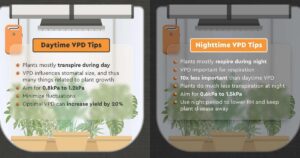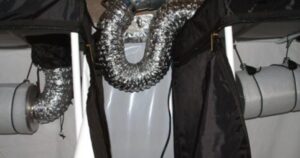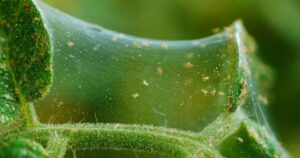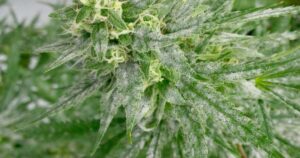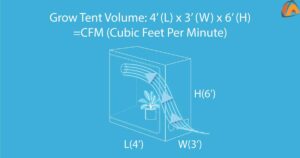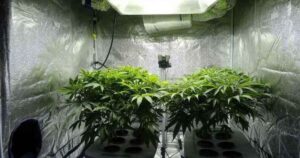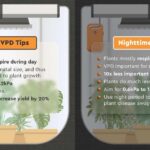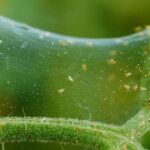Maintaining the ideal environment for plant growth is crucial in indoor gardening. Controlling VPD in a grow tent refers to managing the Vapor Pressure Deficit, a key factor encompassing the relationship between temperature and humidity within the enclosed space.
Curious about enhancing your indoor gardening skills? Wondering how to create the perfect conditions for your plants to thrive? Dive into the world of cultivation by learning the art of controlling VPD in a grow tent. Explore simple yet effective techniques to fine-tune temperature and humidity, providing your plants with an environment conducive to their well-being.
In this guide on how to control VPD in a grow tent, we’ll unravel the mystery behind Vapor Pressure Deficit and its significance in indoor gardening. From understanding the basics to implementing practical strategies, we’ll walk you through the essentials of creating an optimal environment for your plants. Let’s embark on this journey to cultivate a thriving indoor garden together.
Understanding VPD in Grow Tents
Humidity Management for Ideal VPD
VPD is the difference between the moisture inside the plant and the air surrounding it. Maintaining this balance ensures that plants can efficiently absorb nutrients and grow robustly. Too much or too little humidity can hinder this process, affecting the overall health and yield of your plants.
Proper humidity management is like finding the Goldilocks zone for your green friends—just right. For a quick reference, here’s a simple table summarizing the ideal humidity levels for common plants, helping you create the best conditions for your indoor or outdoor garden:
| Plant Type | Ideal Humidity Range |
|---|---|
| Leafy Greens | 40-60% |
| Flowering Plants | 40-50% |
| Succulents/Cacti | 30-40% |
| Tropical Plants | 60-80% |
Keep in mind that these are general guidelines, and slight adjustments may be needed based on specific plant species. Happy growing!
Choosing the Right Ventilation System
Selecting the appropriate ventilation in grow tent for your home or workplace is crucial for maintaining a healthy and comfortable environment. A well-chosen ventilation system ensures the continuous flow of fresh air while removing pollutants, allergens, and excess moisture.
To make an informed decision, consider factors such as the size of the space, local climate, and the specific needs of occupants. Evaluate different ventilation options, including natural ventilation, mechanical ventilation, or a combination of both. Natural ventilation utilizes openings like windows and vents, while mechanical systems employ fans or air exchange units.
Assess energy efficiency, installation costs, and maintenance requirements to find the system that best suits your needs. A properly chosen ventilation system contributes to better indoor air quality, enhances overall well-being, and supports a healthier living or working environment.
Crop-specific VPD Guidelines
VPD is a measure of the atmospheric moisture demand, influencing plant growth and development. Understanding this relationship is vital for optimizing agricultural practices. Different crops have unique VPD requirements, and tailoring guidelines accordingly can significantly enhance crop yield and quality.
For instance, some crops thrive in higher VPD conditions, while others prefer lower levels. To illustrate, lettuce tends to perform well in lower VPD environments, whereas tomatoes may benefit from slightly higher VPD ranges. Implementing crop-specific VPD guidelines empowers farmers to create ideal conditions for each crop, ultimately fostering healthier and more productive harvests.
Monitoring and Adjusting VPD in Real-time
Achieving the optimal environment for plant growth is crucial, and one key factor in this process is maintaining the right Vapor Pressure Deficit (VPD). Monitoring and adjusting VPD in real-time is a game-changer for both novice and experienced growers. Imagine having a smart system that constantly evaluates the humidity, temperature, and airflow in your growing space, ensuring that your plants receive the perfect balance of moisture and heat.
This dynamic approach maximizes photosynthesis, leading to healthier and more productive plants. Real-time VPD adjustments empower growers to respond instantly to changing conditions, fostering an environment where plants thrive. In essence, this ensures that your cultivation efforts are always in sync with the needs of your precious green companions.
Common Mistakes to Avoid in VPD Control
Achieving the right balance is paramount, as deviations can negatively impact plant health and yield. One common error is neglecting temperature and humidity adjustments, leading to an imbalanced VPD. It’s essential to monitor and adjust these factors in tandem to create an environment conducive to plant flourishing. Another pitfall is overlooking ventilation systems, which play a vital role in regulating VPD in grow tent.
Without proper air circulation, humidity levels can fluctuate, affecting VPD stability. Lastly, inadequate insulation can compromise temperature control, emphasizing the importance of a well-insulated environment. In summary, a holistic approach to VPD control, considering temperature, humidity, ventilation, and insulation, is key to maximizing plant growth and productivity.
FAQs
Conclusion
By understanding the relationship between temperature, humidity, and plant transpiration, growers can create an ideal environment that promotes healthy development. Regular monitoring, adjustments, and the use of appropriate equipment are key elements in maintaining optimal VPD levels throughout the different stages of plant growth. Ultimately, a well-maintained VPD ensures that plants receive the right balance of water and nutrients, contributing to a successful and efficient cultivation process in a controlled environment.


